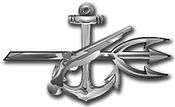Special Warfare insignia
The Special Warfare insignia, also known as the "SEAL Trident" or its more popular nickname, "The Budweiser",[1] recognizes those members of the United States Navy who have completed the Basic Underwater Demolition/SEAL (BUD/S) training, completed SEAL Qualification Training (SQT) and have been designated as U.S. Navy SEALs. It is one of the most recognizable breast insignias of the U.S. Navy.
| Special Warfare Insignia | |
|---|---|
 | |
| Type | Uniform breast insignia |
| Eligibility | United States Navy SEALs |
| Awarded for | Completing Basic Underwater Demolitions/SEAL training and SEAL Qualification Training |
| Statistics | |
| Established | 1970 |
| First awarded | Vietnam War |

.jpg)
History
Established on 16 October 1970,[2] the Special Warfare insignia was initially issued in two grades, gold for officers and silver for enlisted. In 1978 the Silver SEAL insignia was abolished after which the Special Warfare insignia was issued thereafter. The SEAL insignia is therefore unusual in the Navy being as it is one of the very few breast insignia issued identically for both officers and enlisted personnel. This is partly due to the combined training both officers and enlisted receive, side by side, when involved in BUD/S training.
The Special Warfare insignia consists of a golden eagle clutching a U.S. Navy anchor, trident, and flintlock style pistol. The decoration is considered a successor to the obsolete Underwater Demolition Insignia.
The general design was likely derived from the British Combined Operations badge.
Designator and title
Sailors who complete BUD/S training at Coronado California are reclassified to the Special Warfare Operator (SO) rating. Sailors must complete SEAL Qualification Training (SQT) before receiving Navy Enlisted Classification (NEC) 5326 Combatant Swimmer (SEAL) or, in the case of commissioned naval officers, the designation 1130 Naval Special Warfare (SEAL) Officer. Prior to the establishment of the SO rating in 2006, SEAL operators were sourced from regular Naval ratings, with the title of SEAL treated like a warfare qualification, attaching (SEAL) after the rating.
Burial
When a deceased SEAL is buried, fellow and current SEALs will often take their insignia and pin them onto the coffin, then pound them in place with their bare fist. Done as a last farewell, the coffin is buried with the insignias attached to it. [3]
See also
- List of United States Navy enlisted warfare designations
- Badges of the United States Navy
- Military badges of the United States
- Obsolete badges of the United States military
- Uniforms of the United States Navy
- Michael A. Monsoor § Funeral
- Navy SEAL killed in Afghanistan is interred in Toms River § Notes[4]
Notes
- Ismay, John (2019-11-21). "Edward Gallagher, the SEALs and Why the Trident Pin Matters". The New York Times. ISSN 0362-4331. Retrieved 2019-12-23.
- Cummings, Dennis J. The Men Behind the Trident: SEAL Team One in Vietnam. Naval Institute Press, 1997, p. 16.
- navy-seal-trident-insignia.html
- https://www.nj.com/news/2010/09/navy_seal_killed_in_
References
- National Archives and Records Administration, Military Personnel Records Center (U.S. Navy Breast Insignia Descriptions)